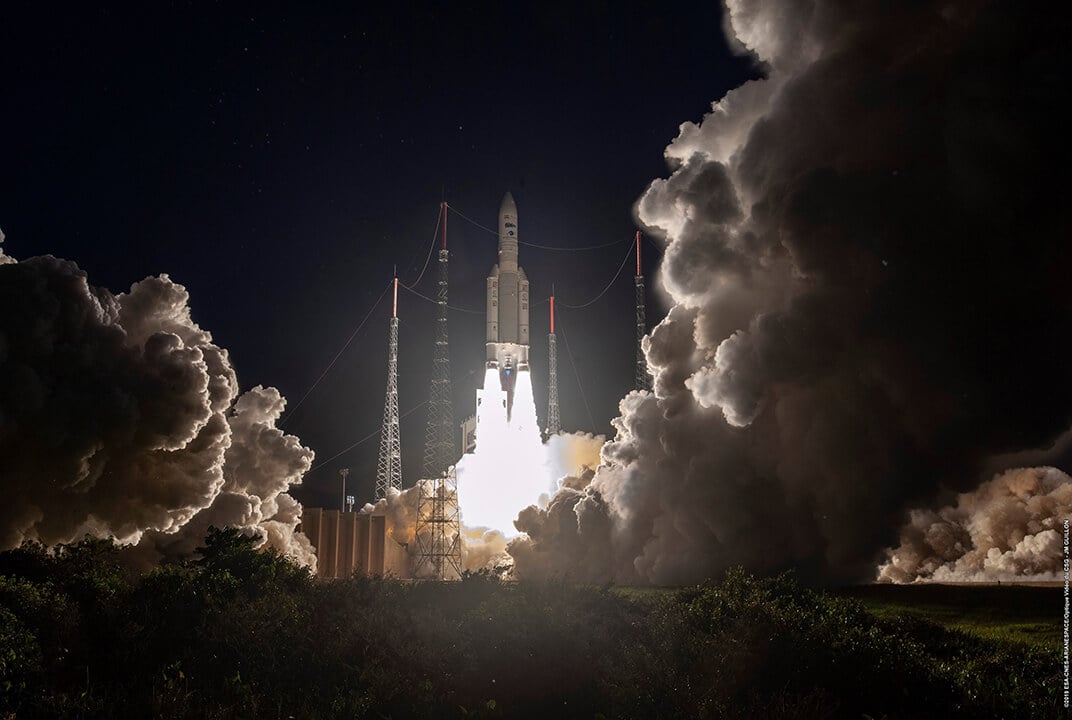Insight | 3, 2, 1…liftoff…separation…. what comes next?
3, 2, 1…liftoff…separation…. what comes next?
Corporate
Inmarsat Senior Spacecraft Platform Engineer Mikael Eriksson describes the fascinating journey the Inmarsat-5 F4 satellite will undertake to reach its final geostationary orbit.
Watching a launch, like that of Inmarsat-5 F4 (I-5 F4), is very exciting, but what happens after the 32 minute spectacular live video of the journey up into space?
With I-5 F4 it is hard not to draw parallels with NASA launches as our spacecraft lifted off from the same pad as the historic Apollo missions to the moon and many of the space shuttle missions. In these cases, control was handed over to NASA mission control in Houston immediately after launch. Inmarsat has a similar approach, but initially we used the Boeing Mission Control Centre in El Segundo, California.
All mission control centres have a very similar organisational structure, like those you have probably seen in live broadcasts from other launches, or in the movies. There is a room filled with highly skilled specialists in all spacecraft design fields. All team members are very dedicated and ready to handle any situation which could arise.
“Houston, we have a problem”
To continue the comparison with NASA missions, I am sure you are familiar with the line “Houston, we have a problem”. Although satellite missions are normally much less eventful, the joint Inmarsat/Boeing spacecraft specialist team had to be ready to deal with any unusual observation or anomaly which might arise. Repeated rehearsal is key for this readiness, as is preparing a large number of contingency procedures should the unforeseen occur. This is a large effort which hopefully will never be put into use. Our goal is for rehearsals to be eventful and the real mission to be completely nominal.
The first key event after separation from the launch vehicle was the acquisition of the telemetry signal from I-5 F4, which happened at 01:04 BST today. The control centre was eagerly awaiting this signal as it is only at this point that we know for sure the spacecraft has correctly handled the harsh vibration and acoustic environment which comes with any launch.
The satellite signal was picked up by Inmarsat’s worldwide ground control network and fed via Inmarsat’s London operational centre to I-5 F4 Mission Control. The first action was to conduct a complete check of the satellite’s status after launch. The same team remotely followed all the spacecraft set-up verification prior to launch, so we know exactly the state to expect.
Some of us also followed all the design and testing of I-5 F4 on the ground, including the final spacecraft testing and preparation at the launch site, so this is long distance communication with an already familiar spacecraft – but one which is now in space, the environment it was designed for.
It’s still a long way to go….
The launch vehicle delivers I-5 F4 to an initial intermediate orbit. We still have a long way to go to reach the final geostationary orbit. The next step is firing up the satellite’s large on-board apogee thruster, which is used for seven manoeuvres, the longest up to 90 minutes’ duration, to bring the spacecraft closer to the geostationary orbit.
Once this is complete the spacecraft is “transformed” by deploying the large solar arrays and reflectors. At launch the spacecraft is a box-like shape so that it can fit inside the tight launcher fairing, but at this point the spacecraft takes on its on-station configuration. This is all completed about two weeks after launch, with the team working around the clock all days of the week. A very intensive phase!
Still the geostationary orbit 35,786km above Earth is not yet reached. For the final step we use the satellite’s highly efficient plasma thrusters. These are significantly more efficient than any other thruster used in the previous steps, but the thrust is so low it takes months with nearly continuous firing to reach the final orbit.
Once in correct orbit, control is switched over from El Segundo to Inmarsat Satellite Control Centre in London for in-orbit testing, after which the satellite is fully operational. A few key people in the team will continue to support spacecraft operation throughout the satellite’s life – but that is another story!
And you might have thought everything was over in 32 minutes?
About the author
Mikael Eriksson is a Senior Spacecraft Platform Engineer in the Space and Systems Architecture Division.
He joined Inmarsat in 1990 and has supervised the design, manufacturing and ground testing of nearly all of Inmarsat’s spacecraft on-site at Airbus, Lockheed Martin, TAS and Boeing, as well as supporting various launch campaigns, most recently with Arianespace, ILS and SpaceX. Mikael is also a key person for the real time operational support for all on-station Inmarsat satellites.
Mikael started his aerospace career with Saab Space in Sweden as a Spacecraft Systems Engineer. He holds a Master of Science (MSc) in Applied Physics and Electrical Engineering.


